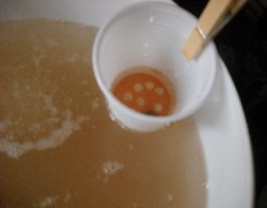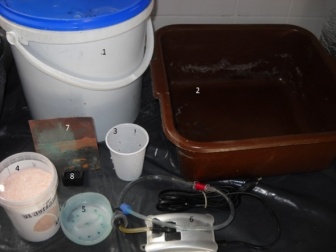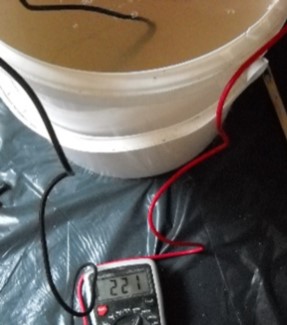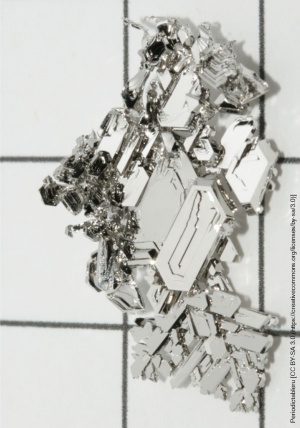The production of a GaNS composite by the use of oxidization
This article is part of the KF Plasma Times July 2019
Published on: July 2019
SUBJECT
This study was conducted to address the question if platinum (Pt), which has a high atomic mass of 195,084u, can be used to produce GaNS.
METHOD
Materials
- For this method 0,7 grams of platinum ‘’blech’’ or platinum ore was used, which is a lump of platinum that can be purchased from here1.
- I recommend buying 1 gram of platinum 99,9%. However, in the third and fourth experiments I have used 5 grams of platinum.
- Five Nano-coated copper plates are used with a thickness of approx. 0,4 mm, 6 cm width and 12 cm length. In the third and the fourth experiments I have used one Nano-coated copper plate T2 with the dimensions 100x100mm and 0,8 mm thickness. T2 is a Chinese abbreviation for ETP
electrolytic tough pitch) copper, the most common copper conductor material, known as C11000 in the USA, in the UK as BS C102 or in West-Germany as DIN ECu-58.
- Mass concentration of pink Himalayan salt: 16,6% (m/v) 1 kg pink Himalayan salt for bathing (red or pink color) in 6 L tap water. The (m/v) is a abbreviation for mass divided by volume which is this case kilogram divided by liter. The formula:
- 16,6% (m/v) = amount of salt in kilograms divided by the volume of the solution which is 6 liters multiplied with 100 = 1kg / 6L * 100%.
- However, in the second and third experiment I have used the same mass concentration with natural sea salt with demineralized water. In the fourth experiment I have used: 503,7 g fine pink Himalayan salt in 10 L tap water which has a mass concentration of 5,0%.
- In the first experiment I have used a 10-liter, square, brown, plastic tray to produce the GaNS. In the second, third and the fourth experiment I have used a 12-liter, polypropylene milk bucket which is Nano-coated on the inside with NaOH.
- An air pump: JBL Prosilent à100: 230V/50Hz, 3W, 100 L/h <37 dB (A) and suitable for aquarium from 40-150L. Model nr ‘’100’’ stands for the flow of air in liters per hour.
- Small plastic cup or small plastic tray (LDPE/PP) with holes that is able to contain the platinum in the solution. I have used the small plastic tray in the first three experiments which is depicted in Figure 1.
- In the fourth experiment I used a small plastic cup which is depicted in Figure 2 (the top-right corner).
- A spacer for the copper plates or copper plate which I have used for all four experiments, depicted in Figure 3.
The materials needed for the production of GaNS are depicted in the Figure 4.
In Figure 4 the materials are numbered 1 through 8 and this is their description:
1. A 12-liter, polypropylene milk bucket.
2. A 10-liter, square, brown, plastic tray.
3. A small polystyrene cup containing 5 g of platinum.
4. 500 gram pink Himalayan salt.
5. A spacer made from a bottom part of a 1 liter HDPE bottle which is an alternative for the spacer mentioned in point 8.
6. An air pump: JBL Prosilent à 100 (Model 100).
7. A Nano-coated copper plate.
8. A HDPE spacer with small cuts of 5 mm to hold the copper plate.
PROCEDURE
The procedure for producing the GaNS is as follows:
- Take the platinum material and rinse the metal from any residue. For copper plates use the following method of Nano-coating: NaOH and then fire-coating (1x). Plates are then homogeneous black. Acetic acid is used to clear up residue and possible alignment of the Nano coating. In the second, third and the fourth experiment I have used a fire-coated copper plate (with butane gas).
- Dissolve 1 kg pink Himalayan salt in 6 liters of tap water: 16,6% (m/v). In the fourth experiment I have used less salt and the salt was finer: 5,0% (m/v) pink Himalayan salt.
- Use a plastic cup and drill holes in it - see Fig 2.
- A HDPE square tube and make cuts next to each other, distance 1 cm.
- Use a 10-liter proper plastic tray or use a 12-liter polypropylene milk bucket to produce the GaNS The five Nano-coated copper plates can be inserted in the cuts in the HDPE square tube.
- Pour in the salt solution and get a small plastic cup or small plastic tray and make small holes in it and put the platinum inside. The holes must be small enough to get the water through but not the platinum.
Make a hole in small plastic cup or small plastic tray and attach it on the edge of the bucket or tray where the GaNS production takes place.
During the GaNS production process use an air pump.
OBSERVATIONS
I started the first experiment on the 2019-May-09 at 2:15pm. The brown GaNS was visible in just over 2 hours, on the same day at 4:20pm. The second and the third experiment gave only blue material, which gathered around the Nano-coated copper plate and which is most likely the CuO2.
The salt solution from the fourth experiment (2019-June-04 10:30pm) had a pink color due to the pink Himalayan salt but within thirty minutes it turned more brownish and the GaNS material gathered as a residue in the bucket and also on the platinum, see Fig. 3, but there is less amount of GaNS than in the first experiment. At 2019-June-05 7:00pm the whole solution was clear, the GaNS has completely settled and the GaNS became browner.
RESULTS
During the first experiment I have produced a large amount of brown material within two hours from starting the experiment (see observations). I did not measure the amount of material. The experiment was ended the next day when the solution was totally clear and there was no more oxidization.
I collaborate with another knowledge seeker who has these skills of being a medium and I was told that this material was an alloy metal which consists of the metals I have used for the production of GaNS. In this case it could be an alloy from copper and platinum. For myself I am not sure, so I theories this as GaNS of PtCu, so the atomic mass can be around: 63 u + 195 u = 258 u and it might be a replacement for the heavy elements such as uranium, plutonium and americium.
In plasma science most GaNSes are oxides of some elements e.g. CuO, ZnO, CO2, etc. Hence in this process one receives small amounts of oxides of both elements i.e. CuO and PtO but also the field balance between the two elements (Pt and Nano-Cu), which is 195-59=136 so it is somewhere around Ba (Barium of 137) - hence the BaO GaNS. This would also count for the fourth experiment which gave almost the same results such as fast brown material production and absence of the blue material. This blue material appears due to the oxidization of CuO, which is only visible after a few days.
During the second and third experiment I have used natural sea salt instead of pink Himalayan salt, which gave only blue material, which is the CuO2 found near the Nano-coated copper plate.
In the first and second experiment, I did not do any voltage reading from the Nano-coated copper plates and the platinum. In the third experiment I did a voltage reading, but there was 0,00mV reading on the Nano-coated copper plate and the platinum.
During the fourth experiment, I have also measured the voltage between the platinum (positive lead) and Nano-coated copper (negative lead) which gave 221mV, this is shown in Figure 5:
At 2:15pm, 2:45pm, 3:15pm, 4:00pm that day, the voltage gave a maximum reading of 340mV, 403mV, 453mV and 430mV respectively. At 2019-June-05 2:45pm the voltage gave a maximum reading of 535mV. So, during the production of the GaNS there is energy in a form of electricity released. The pH of the solution measured on 2019-June-06 at 7:30pm was around 7.
I have applied the GaNS of PtCu in a patch from the first experiment, not the liquid plasma of the GaNS of PtCu. I have used it with other GaNS patches such as CO2 GaNS, CuO2 GaNS and ZnO GaNS.
By layering the patches on the body with the lowest molecular mass such as GaNS CO2 which comes first to the body, then GaNS of CuO2 patch, then GaNS of ZnO patch and then the GaNS of PtCu patch, I could feel what I refer as a small ‘’electrical’’ discharge in my body. Other applications such as creating a huge plasma potential in Magrav systems (instead of using the GaNS of Uranium) might be very useful since the very high atomic mass.
Oxidization is a halfway interaction between the gaseous and matter state of two elements that both elements can have a connection between the two.
Oxidization is the process of disbalance of two elements, iron and oxygen, which will interact with each other through electron transfer: iron will supply two electrons and the oxygen will take those electrons creating a brown oxide: iron(II)oxide.
Both elements acts as a magnet. Whenever you have iron (which has a disbalance), you need a balancer, in its environment. To balance, the iron receives the oxygen. The atoms become part of one molecule and/or salt, but each element has its own position in the total plasma. In fact, any element can be oxidized. This process of oxidization is also mentioned in the 177th Knowledge Seekers Workshop [1] mark 3:18:05.
While conducting the experiment by using a Nano-coated copper plate and platinum to create the GaNS, there is a possibility that the environment allows to oxidize those metals if there is a halfway interaction between the gaseous part and the matter part.
In this case, the copper is Nano-coated and would be able to create gas in Nano state which would be gaseous part and the platinum would be the matter part.
With the use of the right salt (pink Himalayan salt) it would create the right condition to create an alloy: platinum-copper or PtCu. This is theorical because it is not confirmed and also not verified.
It is also possible to oxidize platinum to create platinum-oxide under known conditions. Several platinum-oxides are known such as platinum(II)oxide and platinum(IV)oxide. It might be possible that during the experiment these oxides were created. However, I am not sure.
In conclusion, the brown GaNS material could only be produced if there is a Nano-coated copper plate, platinum, aeriation in a pink Himalayan salt solution.
In the fourth experiment I have used less mass concentration of pink Himalayan salt, but there is also less GaNS being produced.
The results can be repeated; however, it looks like the concentration of the pink Himalayan salt determines how much GaNS gets produced.
REFERENCES
- https://www.zujeddeloh.de/produkte/goldschmiedebedarf/halbfabrikate/legiermetalle_-_195.html
- M.T. Keshe. 177th Knowledge Seekers Workshop, June 22, 2017. [Online]. Available: https://www.youtube.com/watch?v=HldaF-RMors&t=11885s. [Accessed June 2019].






